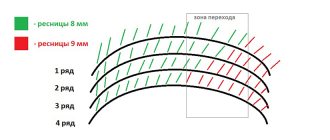34
The correct setting of an anchor in NLP, or anchoring, consists precisely in the fact that after setting a positive anchor, you find the very thing - the right, positive experience that can cover up your negative experience
(NLP Techniques)
The term “anchor” is already so widely popular that even people who are only familiar with NLP by hearsay connect these two words in their minds according to the principle: “We say anchor, we mean NLP, we say NLP, we mean anchor.”
This quote, reformulated by me, is, by the way, one of the clearest examples of typical “anchoring”: when we say one thing (that which is an anchor in NLP), and a completely different (useful or, on the contrary, harmful) resource comes to mind state.
So. I remind everyone what exactly is meant by the term “NLP anchor”. In one of its general meanings, an NLP anchor is a very strong conditioned reflex connection established consciously or unconsciously.
Anchors in NLP are natural and working, for example, those that are “made” artificially for you by the NLP therapist during the process of NLP therapy. Artificial NLP anchors represent (usually) touching some part of the partner’s body.
Now we will talk about the process of artificial, working anchoring.
You can “anchor” certain resource states yourself, without the help of a second partner, and even without the help of an NLP therapist. True, there are some peculiarities here, but we will talk about them a little later.
So. We move on to describe the algorithm for establishing a tactile artificial NLP anchor - with the goal of replacing a persistent negative experience with a positive one
.
We establish an NLP anchor in pairs, working with a volunteer partner.
Collapse of anchors
Having heard all these passions, people immediately begin to understand that many anchors were vilely formed in the wrong way, with the wrong incentive and for the wrong condition. — There is a tone of voice that causes irritation. - This is his pose, brrrr. — As soon as I hear the sound of the alarm clock, I immediately want to sleep. “This fabric gives me such an unpleasant feeling inside.” How to remove these incorrect anchors? It's actually quite simple - it uses the collapse of anchors. The word “collapse” has several meanings, but in this case the closest one is destruction. As in astronomy - the collapse of a star. It's really very similar, because after the collapse there is nothing left, no anchors. You trigger a stimulus - and there is no reaction, there is no longer a conditioned reflex, it has collapsed. And in order for something to collapse, we need two anchors, opposite in sign, but approximately equal in strength. And if we launch them simultaneously, we will observe this very collapse. It looks really funny from the outside. For example, we anchored irritation to squeezing a touch on the right hand, and calmness to a touch to the left. They anchored it correctly, everything was done according to the steps described above, they checked it: they touched the right hand - it got irritated, they touched the left one - it calmed down. And then once - and they touched both hands at the same time. And so it began. It often looks as if one part of the face is expressing one emotion and the other the opposite. It can be either right-left or up-down. And then gradual smoothing begins. Sometimes it all looks like successive waves - sometimes plus, sometimes minus. But gradually the waves calm down... After everything has calmed down, you can check whether the anchors have collapsed - after the collapse of the anchors, the stimulus-response connections are destroyed. If you touched your right hand - nothing, if you touched your left - nothing either. But an unpleasant experience can be quite strong. This is where anchoring comes in handy. You remember that for collapse the anchors must be close in “strength”. This “power” can be organized not only through one powerful experience, but also through the sum of small ones. As with scales, you can put one kilogram weight on one bowl, and five two hundred gram weights on the other. Want to try? Let's. Select the anchor you want to destroy. For example, it could be an unpleasant memory of some situation in the past. Or a regularly recurring situation - like an annoying tone of voice that irritated you a year ago and yesterday. Imagine this situation in the form of a small image and place your left hand. And on the right, also in the form of images, you begin to add resource states - pleasure, joy, happiness, delight, humor, peace. Until the right hand is one and a half to two times larger. It is clear that for collapse you need anchors that are close in “strength”, but this is precisely the case when it is better to be on the safe side. Once you dial it, you begin to slowly move your hands together. They brought them together and squeezed their palms. We waited - there was no bang. Now think about the situation you worked with - how is it, is it better? Wow. This is how the collapse of anchors works. But not only anchors of opposite sign can be launched simultaneously. For example, you can anchor happiness on one hand and surprise on the other. And launch both anchors at the same time. The result will be some kind of third state, quite often completely unfamiliar to the person. - This is something new for me. Some kind of joyful amazement or something. When anchors of the same sign are launched simultaneously, they usually talk about the integration of anchors. That is, about unification. You can also play around with this and get quite a lot of new interesting states.
In general, any simultaneous launch of anchors is integration. And the collapse of anchors is a special case of this very integration.
In order for the anchors to integrate (or collapse), the anchors must be turned on at the same time for about a minute. Full integration takes much longer, but the main changes occur in the first minutes.
Rules for using anchors
A conditioned reflex is the result of learning. The brain noticed that a state (sadness, fear, happiness, joy) and some action (facial expression, voice intonation, posture) occur simultaneously and it connects them with each other. And as soon as the stimulus appears, it triggers the corresponding state. That is
An anchor is a connection between stimulus and response.
For example, We are in some situation, for example, we went outside on New Year’s Day to set off fireworks. The state was joyful, cheerful, and then “zip” - a rocket took off, sparks in all directions. The brain noticed this and learned that if there are fireworks, we launch joy. Fireworks are a stimulus, fun is a reaction.
There is one subtlety here. Anchors "disintegrate" after a few hours if they are not reinforced. In order for the anchor to live for a long time, the anchor needs to be set two or three more times.
So, to set an anchor you need two things: the peak of the state and the originality of the stimulus. With the peak it is more or less clear - the state has reached its maximum and here we install an anchor. At the same time, it is important that the person has not yet left this peak; the stimulus must be “inside” the state so that the brain decides that they are connected. For example, a person is rejoicing, and at that moment you tap your finger for several seconds until he stops rejoicing. Then, with exactly the same finger tapping, the person will rejoice again.
But the stimulus itself should be somewhat unusual in this situation - a slightly unusual pose, tone of voice, knocking, touch, position in space. This does not mean at all that you have to portray something unimaginable; you can simply lower your voice a little - but at the same time keep this pitch of the voice at the same level. Or tilt your head and don’t move it while you set the anchor. This means that you usually do not speak in this particular tone of voice and do not hold your head in this particular position. This, in fact, is the “originality of the stimulus.”
An anchor can be: touch, intonation, pitch of voice, place, position in space, gesture, posture, time, internal image, melody, object, movement, sequence of actions, smell and much more.
What else is needed is the accuracy of the anchor reproduction. That is, you reproduce the anchor extremely accurately: exactly the same sound or word, pronounced with exactly the same intonation, exactly the same movement or touch.
For example, some believe that if you press harder when reproducing a kinesthetic anchor than during installation, then the reaction will be more intense. But no, the result will be worse (if at all).
So we have a set of rules for using anchors.
Anchor at the peak of the condition.
Use something unusual in context for the stimulus.
Reproduce the stimulus accurately.
In practice it looks like this. The Operator asks the Client to enter a state: “Please remember a situation when you were truly relaxed. Get used to it, feel it.” And he carefully calibrates the Client’s state: take a deeper breath, the facial muscles relax, a slight symmetrical smile appears, the shoulders drop and it seems like nothing else is changing. And at this moment the Operator touches the Client’s shoulder. After this, he interrupts the state, for example, offering the Client a distraction: “By the way, what are you going to do tomorrow?” What should be done after this? That’s right, check whether it works or not, otherwise we can consider that we have installed an excellent anchor, and the Client’s brain does not even suspect it. So the Operator waits for the Client to enter a neutral state, and then touches his shoulder again - in the same place, with the same force - and calibrates how the Client’s state changes. If the muscles relax, breathing becomes deeper and a smile appears, the anchor is set. Then this anchor can be used, for example, to return the Client to a state of relaxation if he is too tense from something or to add relaxation to a situation where it is needed.
Using Anchors
Well, we talked about what anchors are. Now a little more about how they can be used. And how they are used. The most common use of anchors is to trigger the desired state at the right moment. I anchored confidence and launched an anchor during an interview, anchored attention and launched an anchor during a lecture, anchored calmness and used this anchor when talking with my mother-in-law. Or imagine a coaching session. Can't you imagine? Two people are sitting and talking. One tells what he would like to improve in his life, and the second gives him advice and generally leads him to a bright future. So, when we go to a bright future, there is a point from where we are going, what we want to change - in NLP it is called the current state - there is a point where we are going - the desired state. A train left from point A to point B... A coach is someone who helps a client go from point A to point B, a guide, so to speak, who usually sets at least three anchors for the client. The first is for the current state to check if the problem is resolved. If resolved, the anchor to the current state collapses. The second anchor is on the desired state, so that you can see where you are going. And the third anchor is in a neutral state, so that if you wander into an unknown place, you can always return to the beginning. And you can also imagine a coach. Not the football one, but the one that teaches. Psychology, sales, NLP. Since I teach more NLP, I will write about NLP training and the use of anchors. Is the resource state of a coach important? Naturally, it’s important to know why the trainer is in a bad state, and what he will teach. So you can put a bunch of useful anchors in your trainer’s workspace. Literally on the floor you walk on - such anchors are called spatial. And on this floor you can add anchors, putting there everything that may be needed for work: confidence, cheerfulness, calmness, attention, relaxation, humor, joy, all sorts of abilities... Anchors are also useful in explaining. For example, I talk about the types of people - visual, auditory, kinesthetic and digital. There is a lot of information, and you need to help listeners sort it into groups - this here, this there. And this can be done using markings - anchors that mark each pile of information. — People can be divided into four types. There are visual people,” I point my hand upward to the right, this will be “anchor B”, because with it I throw a bunch of information about visual people, “these are those who prefer to see. They speak faster, gesture more in the upper body, and sit upright. And there are kinesthetics - a gesture to the right downwards, we will have an “anchor K” - they are more oriented towards experiences, feelings. Their voice is lower than that of visual learners, they speak more slowly, and they gesture in the lower part of their body. There are also auditory people - a gesture to the left in the middle, “anchor A” - these are those who prefer to hear. They have few gestures, but they convey everything with their voice. And they also love to talk. If a person answers the question “how are you living?” starts talking about his life, then most likely he is not a bore, but an auditory learner. Another type is digital - gesture down to the left, “anchor D” - they are so very special. Because they are more focused on the content of speech. So they don’t have many gestures, since they don’t carry information for them, and their voices don’t really work either. - So. Some - gesture to the right upward, "anchor B", and the unconscious of the listeners knows in which pile to put this information, that this is about visual people - in films they love colorful action, pictures. Others - gesture down to the right, “anchor K”, information is put into a pile marked “kinesthetic” - love action. There are all sorts of chases and action. Still others need good sound - hand to the left, “anchor A”, a bunch of “audio” - they value good sound first of all. And so on. When telling and comparing types, using anchors it is very convenient to put it all into different piles. Moreover, as you understand, we mark and set anchors all the time. And some manage to make this very marking completely chaotic. So he “put” the planes on the left and the tanks on the right. And then for some reason he began to lump everything into one pile on the left - and the listeners were very confused, either the tanks were flying or they had attached tracks to the planes. You can also use marking to set evaluative anchors. “You know, it happens like this, you come to the store, choose what you need, come home, unwrap it and realize that it’s not at all the same,” the voice is lower, “an anchor for disappointment.” “And sometimes it’s quite the opposite, you take a long time to choose, come home, unwrap it and realize that this is exactly what you’ve been looking for,” the voice is higher, “an anchor for satisfaction.” Anything can happen. Here in our company,” the voice is higher, “anchor for satisfaction,” “there are many interesting offers. There are similar ones in other companies - the voice is lower, “anchor for disappointment” - and also quite interesting. And no matter what words are said about other companies, somewhere inside the listeners a worm of doubt and incomprehensible disappointment with these “other companies” settles. Do you know how sometimes girls try to make you fall in love with them? They put a bunch of positive anchors, and then transfer them to themselves (though most often quite unconsciously): “Remember your first crush... What do you like most about girls? What do you get the most pleasure from? How do you feel when you kiss? Oh look at my new hairstyle." And when working with a group, this very group can be anchored by attention, and when they begin to get distracted, and the topic is more important, use it. You can set an anchor for calm for a work colleague and use it after he returns from communicating with his boss. You can set the same anchor for yourself and use it in the same situation. Or you can simply add resources to the situation of communicating with your boss - the situation is on one hand, communication with the boss on the other, and collapse. You can set an anchor for the buyer to make a decision and launch it - well, so that he already makes this very decision. In general, you can do a bunch of very interesting and useful things with anchors. This includes removing unnecessary and harmful anchors.
Let's practice
Why bother at all, find out what an anchor is in psychology, install it, remove it?
It's all about the opposite effect. Let me give you a simple example. Let's say a week ago you recorded an extraordinary surge of positive emotions in a girl after a blowout. Now you want to get this state from the girl again, you just activate the anchor, and that’s it. Thus, anchoring in psychology was invented with the goal that you would receive the desired state from your interlocutor almost instantly. You get your hands on a very powerful tool that can work years after installation.
On cats
To hone your anchoring skills and in the future not wonder how to anchor a woman, practice it on yourself.
The tool is unique in that it even works on you. Even if you consciously set it for yourself and activate it yourself. Right now, take it and analyze your behavior, your surroundings with things, symbols. Personally, I still associate one song with simply magical sex with one girl. And this was already 5 years ago. And when I hear it, I return to this state of euphoria, even against my will. The anchor was set while I was in bed with her, that's all.
Right now, try to anchor yourself, for example, with a sense of self-confidence. Focus and relax. Stretch your memory and remember a situation, or better yet several, in which you were 100% sure, and it was justified, as practice later showed. Choose the most powerful memory. Remember everything in the smallest detail, how you moved, how your body felt, how other people talked to you, little things, accessories, clothes, just everything. Try to transport yourself to this state, as if you were there now.
When you concentrate, you will completely enter this state, one might say, you will renounce the present, just press forcefully with one hand on the other. Stay in this position for a little longer and gradually return to the present. Congratulations, the magic button on your body has been invented!
But there is a caveat. This anchor will not work right away. It will need to be reinforced several times while you actually feel confident in yourself. After several repetitions of the same movement, in moments of confidence, this state will return to you when you repeat the action and activate the anchor.
Another person is anchored in exactly the same way. Just don't overdo it with effort. This is not necessarily a click. Just an unusual movement or action. A sliding anchor works well, but it is also more difficult to set up, since it is artificial and complex. First, you set the anchor to the initial position with a touch, then with your voice you enter into the state that you need, accompanying all this with movement. At the end you put a point when you reach the desired state. Now you know how to anchor a woman. Use it!
Selection of incentive
The selection of a stimulus for an anchor, as well as the selection of clothing, must be approached carefully. Because an inconvenient stimulus can ruin the whole raspberry - it’s like uncomfortable pants, it’s like eating, but walking and sitting are terribly uncomfortable. Look, if you set an anchor for yourself - well, to add confidence or calmness at the right moment - you need the triggering stimulus to be turned on at the right moment, and turned off at the unnecessary moment. And it is advisable not to be particularly distracted by maintaining this very stimulus, otherwise if you use an imaginary green triangle to launch the anchor, then as long as you remember the triangle, you have confidence, but if you get distracted, the confidence disappears somewhere. The anchor is like a bell button - as long as you press on it, there is sound, but you remove your hand and the sound disappears. It is also desirable that this very stimulus does not strain the people around you - you can, after all, use clenching your hand into a fist for this purpose, but they will not understand. So the task is not easy. What can you offer? It’s good to place anchors on your fingers, as I already described - lightly pinch the index and thumb (or middle and thumb, or ring and thumb). You can be slightly distracted yourself, your fingers most likely will not move apart. If you don’t do this demonstratively, then others won’t even notice. You can use some kind of melody, more obsessively - it spins in your head and spins. If you need to be in a state for a long time - during an exam, negotiations, when making acquaintances - you can make an amulet or talisman. For example, anchor the desired state on a jacket, ring or pen - you remember the state of confidence, put on the jacket, take off the jacket, get distracted, repeat all this two or three more times. You can even hang several states on this very jacket: confidence, calmness, relaxation, and vigor. This is the so-called superposition of anchors - when you attach different states to the same stimulus. It is clear that applying anchors will work not only with the jacket, but also with the ring, and with the pen, and with the fingers, and with the imaginary green triangle. By the way, quite convenient stimuli for such situations can be smells - perfume, deodorant, or even chewing gum. Smells are generally good anchors. But they set anchors not only for themselves, but also for others. And here there are subtleties. It is clear that the stimulus, as when installing it for yourself, should be convenient - easy to start, easy to turn off. Unless you need to keep a person or people in the desired state for a long time, music and smells are just good here. At all kinds of yoga, meditation and other esoteric gatherings, Indian music and stink sticks are often played. And this smell is often quite a good anchor - a person came to class, sniffed the smoke and immediately calmed down, relaxed and entered the desired state. The stimulus should not knock you out of the state - the whistle is clearly audible, but people get scared. Or if you grab a girl by the knee - which is quite convenient when you are sitting next to her - she often comes out of the desired state. Maybe, of course, she is pleased, but the emotion has already changed. So choose something that is completely acceptable in the situation. It doesn’t have to be something very noticeable - it could be a characteristic pose or gesture, facial expression, intonation of voice, place in the room. Of course, you can touch a person, which is very good from the point of view of reliability - kinesthetic anchors are the most reliable - but only if this is normal in this context. It looks strange when a person was sitting quietly, sitting - and suddenly jumped up and began to grab you in different places. True, if you have an “official” relationship - you are the Operator, he is the Client - then it is much simpler. You can simply warn (or better yet, ask permission) that you will touch. Yes, the stimulus should not trigger old anchors, otherwise it is not clear what is anchored there. That is why it is not recommended to place kinesthetic anchors on the outer side of the shoulders and hips - we travel on public transport, accidentally touch people in the corridors and, just as accidentally, touch the outer side of the shoulders and hips to various jambs and doorways. Can you imagine the state in the subway at rush hour or when you hit a doorframe? There are many other convenient places for kinesthetic anchors - forearm, hand, back, etc. So to set anchors on other people, you can use a characteristic pose, head tilt, facial expression - just remember that this same pose, head tilt, and facial expression must be maintained the entire time you keep your interlocutor in the desired state. You can also use all sorts of scratching and stroking yourself, such as twisting a ring on your finger or touching your ear. Voice tone works well - pitch, speed of speech, volume - but you will have to speak at exactly that speed or volume while you maintain the desired state with the Client. That is, practically no intonation accents. So an incentive to anchor (both for yourself and for others)
comfortable, easy to hold, does not knock you out of the desired state and is acceptable in the context.
Anchor overlay
Sometimes you need to create a big, big, mighty, mighty anchor. To demolish all barriers. Moreover, it is not necessarily positive - often possible negative anchors are required. For example, a person wants to quit smoking. They gave him a “swing”, but he wants to be absolutely, absolutely sure, so that he certainly doesn’t want to. Then this very powerful, powerful negative anchor is taken and created - a bunch of unpleasant, unpleasant states are superimposed on the same stimulus (cigarette). For example, disgust, disgust. But imagine that you bite into an apple, and it’s rotten inside. Imagine meat with worms crawling around in it. Remember the smell of rotten meat. And all this is anchored on a cigarette. So that the mere thought of smoking makes you feel sick.
Just don’t do such a thing without the “Swing”. Otherwise there will be disgust, but there are no new ways to satisfy the intention and secondary benefits. And it will turn out like in the joke “the mice injected themselves, cried, but gnawed the cactus.”
Since this is the very imposition of anchors. It's actually very simple. Make a list of the required resource states. For example, you need calm, self-confidence, happiness, humor, energy, relaxation, creativity and balance to be able. And you start with each one in turn - you chose a state, brought it to the maximum, anchored it, got distracted. And the most important thing is that all states are anchored to the same stimulus. For example, the “lucky jacket”. Or the equally happy squeezing of your index finger and thumb. As a result of overlaying anchors, you get a very funny thing - something like a big pile from which you choose what you need. Just imagine, you came to the library, to the reading room, selected the books you needed for work and put them on your table so that they were at hand. And although sometimes you really need big, big negative anchors, much more often you need big, big positive ones. To get a big, big resource. Or such a “library of states”. And most often, such a large, large resource is used to collapse anchors. About which below.











